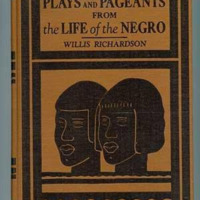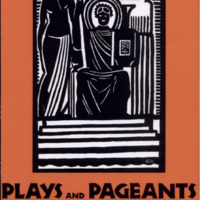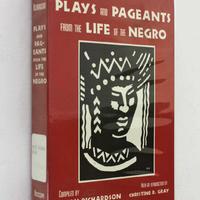-
Title
-
Plays and Pageants from the Life of the Negro
-
This edition
-
"Plays and Pageants from the Life of the Negro" . Ed. Willis Richardson. Washington, DC: Associated, 1930. 373 pp.
-
Other editions, reprints, and translations
-
• Repr. with Intro. Christine R. Gray. Jackson: UP of Mississippi, 1993.
-
Table of contents
-
Willis Richardson / Introduction
Plays:
• Thelma Myrtle Duncan / Sacrifice
• Maude Cuney-Hare / Antar of Araby
• John Matheus / Ti Yette
• May Miller / Graven Images
• May Miller / Riding the Goat
• Willis Richardson / The Black Horseman
• Willis Richardson / The King's Dilemma
• Willis Richardson / The House of Sham
Pageants:
• Inez M. Burke / Two Races
• Dorothy C. Guinn / Out of the Dark
• Frances Gunner / The Light of the Women
• Edward J. McCoo / Ethiopia at the Bar of Justice
-
About the anthology
-
• The anthology includes pageants as well as plays: "Pageants differed from conventional plays in several ways: they were presented on an epic scale, with their power and effectiveness derived from the sizeable cast and elaborate set; performances were often held in a large space, often outdoors; events or figures important to the community were celebrated; the presentations were episodic, having usually three to seven sections. Rather than having a plot with the climax in the central act, a pageant was 'the story of an idea,' and the performance moved toward a finale that included a procession of historical figures or a cavalcade of attributes or virtues such as Truth, Freedom, and Beauty. Certain formal features were constant: a prologue introduced the story to the audience; tableaux and musical interludes, either vocal or orchestral, sometimes both, were included and a 'march past,' where the cast at one point gathered on stage in costume, ended the presentation" (Christine Gray's 1993 introduction, p. xxvii).
-
• "The illustrator for 'Plays and Pageants' was James Lesesne Wells (1902-93). Born in Atlanta, Wells came to New York in 1919 where he studied art at the National Academy of Design. From 1926 until his retirement in 1968, he was on the faculty of Howard University School of Art. In 1929, Wells began teaching print-making at Howard. In his book 'Modern Negro Art' (1943), James A Porter, an art professor and contemporary of Wells at Howard, noted that the artist was the 'dean of Negro print-makers' . . . With ten full-page woodblocks depicting scenes from various texts, Wells decorated the pages of 'Plays and Pageants' with small block prints, all relying on strong lines to lend a starkness and an understated quality to the collection. . . . Passages from the poetry of Paul Laurence Dunbar and James Weldon Johnson accompany Wells's prints" (Christine Gray's 1993 introduction, pp. xxxiv-xxxv).
-
Anthology editor(s)' discourse
-
• In his introduction, Richardson notes that plays written in dialect have been excluded from the anthology.
-
• In her introduction to the 1993 reprint, Christine R. Gray remarks: "With this facsimile edition of 'Plays and Pageants from the Life of the Negro,' a chapter of African American literature is revived. . . . This republication of 'Plays and Pageants' is an attempt not only to preserve the plays and pageants here but also to recognize the efforts of these playwrights. As such, this new edition is a belated tribute to some of the pioneers of African American drama" (xxxvii).
-
• Although the anthology was edited by Willis Richardson, it was published by Carter Woodson's Associated Publishers in Washington, DC, and Christine Gray interprets Woodson as the presiding spirit behind the anthology (vii): his desire that African Americans should know their own history; the contributions they have made to culture, thought, and values; and their responses to the world around them through various eras of history gives this volume an educative function (viii).
-
Reviews and notices of anthology
-
• Edmonds, Randolph. "Some Reflections on the Negro in American Drama." "Opportunity" 8 (Oct. 1930): 303-05. [Google Books]
"One would naturally expect Negro plays by Negro authors to reveal the soul of the black man, to give us something of the beauty and grandeur contained in 'The Green Pastures' [a play by Marc Connelly (1930), adapted from Roark Bradford's 'Ol' Man Adam an' His Chillun' (1928)]: but unfortunately this is not so. These plays are very hard to get, most of them existing largely in manuscript form . . . Willis Richardson, Eulalie Spence, Georgia Douglas Johnson, John Matheus, Mae Miller, and Frank Wilson all won prizes in the 'Crisis' and 'Opportunity' contests, and with Wallace Thurman and Garland Anderson have established themselves as the leading playwrights of color. Most of them are known for their one-act plays, some of which have appeared in important collections and productions.
"'The Plays of Negro Life,' edited by Alaine [sic] Locke and Montgomery Gregory; 'Plays and Pageants of Negro Life' [sic], edited by Willis Richardson; the Negro play number of the 'Carolina Magazine,' and the prize plays of the various contests give some indication of the kind and quality of Negro plays by Negro authors. As a whole they deal with the same subject matter, with the same type of characters as those of their Nordic contemporaries. Very little originality is manifested, and certainly there is no more piercing insight into the depths of Negro life indicated. Still further there is no catching the joyful and poetic side of life beyond the color line, no subtle suggestion of tragedy that rises in ominous overtones from black philosophy. Negro drama, as written by Negroes, is too stilted, too restrained, directly imitative of white authors, and as a rule inferior in craftsmanship with long literary speeches and almost no theatric values" (304-05).
-
Google Books
-
• In contrast to Edmonds' comment about "Green Pastures," we might note Christine Gray's remarks in her 1993 introduction to "Plays and Pageants": "In Marc Connelly's play 'Green Pastures' (1930), based on Roark Bradford's book 'Ol' Man Adam an' His Chillun,' a black preacher teaches Sunday school lessons based on stories from the Old Testament. This play . . . was awarded a Pulitzer Prize for drama. The plot, however, was, as one critic has written, 'one white writer's version of another white writer's version of one black preacher's version of heaven' [Bruce Kellner, ed. 'The Harlem Renaissance: A Historical Dictionary for the Era.' New York: Methuen, 1987. 144]. With heaven represented as an eternal fish fry, the hugely popular play relied heavily on stereotypes by featuring a black preacher, child-like blacks, and an assortment of silly angels, all speaking in thick dialect" (xv-xvi).
-
Commentary on anthology
-
• From Christine Gray's introduction to the 1993 reprint of the anthology: Gray notes that this anthology was advertised in the "Afro-American" for 7 Feb. 1931 alongside various non-fiction works on Negro history by Carter G. Woodson: "That this anthology was published under the aegis of Woodson and promoted to commemorate important incidents and figures in African American history suggests that this anthology had a greater purpose than to entertain. Its mission was to educate" (viii).
"In publishing 'Plays and Pageants,' he [Woodson] gave teachers a collection of materials to use in teaching black students their own history. He hoped to engage them in actively learning that history by having them participate in stage works written by African Americans" (viii).
• Gray offers a brief biographical sketch of the editor, Willis Richardson: "Born in Wilmington, North Carolina, in 1889, Richardson and his parents moved to Washington, D.C., after the riots over blacks voting in the November 1898 election. They had hoped that Washington would be, as he wrote in his brief autobiography, 'the promised land.' Richardson's fortune, however, was not to be found there or really any place. After graduating from the M Street School (later Dunbar High School), he was awarded a scholarship to Howard University. Because of his family's strained financial circumstances, however, Richardson was forced to turn down the scholarship and seek employment. For forty-five years he was not able to commit his life fully to writing; instead, he supported his wife, Moss; three daughters; two grandchildren; and convalescing relatives. Although Richardson's 'Broken Banjo' was published in 'UJSAG', a Hungarian newspaper, in 1931, and his plays were read on the radio, and produced at black schools and colleges throughout the United States, he continued to work as a clerk at the Bureau of Engraving and Printing until his retirement in 1954. In all, he wrote approximately forty-eight plays, sixty poems, and several short stories. Largely unrecognized for his contributions to black drama, Richardson died in Washington in 1977" (xxii-xxiii).
• Lorenzo Greene, who worked as Woodson's assistant, was involved in work on the proofs of the anthology in early December 1929 and noted that he "wanted to make dramatic and literary corrections in the various plays," but he was "overruled by Dr. Woodson and Mr. Richardson on the grounds that we could not tamper with the author's [sic] intentions" (quoted in Gray's 1993 introduction, p. xxvi).
-
Cited in
-
Rowell 1972: 63] [Hatch 1991: 191] [Kinnamon 1997: 474]
-
Item Number
-
A0029





